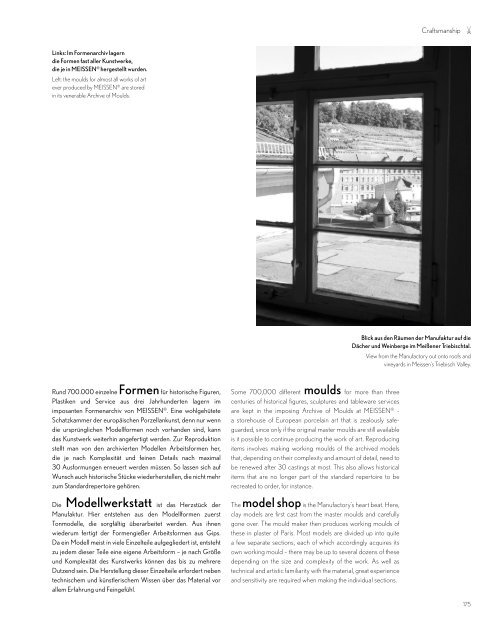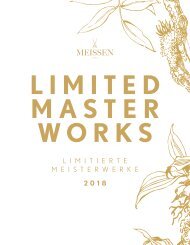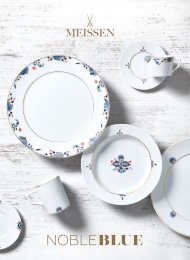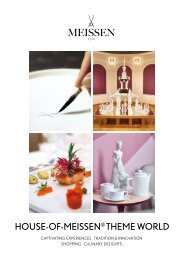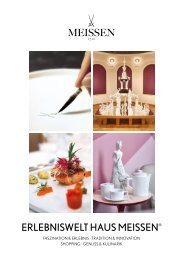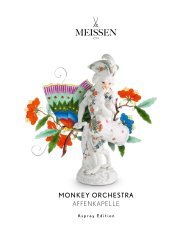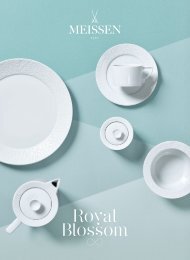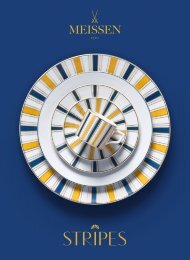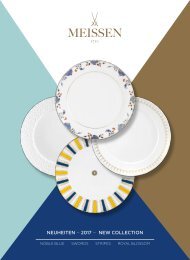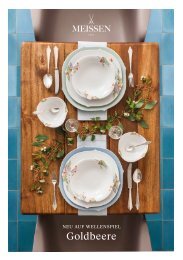MEISSEN Limitiere Kunstwerke 2017
Sie wollen auch ein ePaper? Erhöhen Sie die Reichweite Ihrer Titel.
YUMPU macht aus Druck-PDFs automatisch weboptimierte ePaper, die Google liebt.
Craftsmanship<br />
Links: Im Formenarchiv lagern<br />
die Formen fast aller <strong>Kunstwerke</strong>,<br />
die je in <strong>MEISSEN</strong> ® hergestellt wurden.<br />
Left: the moulds for almost all works of art<br />
ever produced by <strong>MEISSEN</strong> ® are stored<br />
in its venerable Archive of Moulds.<br />
Blick aus den Räumen der Manufaktur auf die<br />
Dächer und Weinberge im Meißener Triebischtal.<br />
View from the Manufactory out onto roofs and<br />
vineyards in Meissen’s Triebisch Valley.<br />
Rund 700.000 einzelne Formen für historische Figuren,<br />
Plastiken und Service aus drei Jahrhunderten lagern im<br />
imposanten Formenarchiv von <strong>MEISSEN</strong> ® . Eine wohlgehütete<br />
Schatzkammer der europäischen Porzellankunst, denn nur wenn<br />
die ursprünglichen Modellformen noch vorhanden sind, kann<br />
das Kunstwerk weiterhin angefertigt werden. Zur Reproduktion<br />
stellt man von den archivierten Modellen Arbeitsformen her,<br />
die je nach Komplexität und feinen Details nach maximal<br />
30 Ausformungen erneuert werden müssen. So lassen sich auf<br />
Wunsch auch historische Stücke wiederherstellen, die nicht mehr<br />
zum Standardrepertoire gehören.<br />
Die Modellwerkstatt ist das Herzstück der<br />
Manufaktur. Hier entstehen aus den Modellformen zuerst<br />
Ton modelle, die sorgfältig überarbeitet werden. Aus ihnen<br />
wiederum fertigt der Formengießer Arbeitsformen aus Gips.<br />
Da ein Modell meist in viele Einzelteile aufgegliedert ist, entsteht<br />
zu jedem dieser Teile eine eigene Arbeitsform – je nach Größe<br />
und Komplexität des Kunstwerks können das bis zu mehrere<br />
Dutzend sein. Die Herstellung dieser Einzelteile erfordert neben<br />
technischem und künstlerischem Wissen über das Material vor<br />
allem Erfahrung und Feingefühl.<br />
Some 700,000 different moulds for more than three<br />
centuries of historical figures, sculptures and tableware services<br />
are kept in the imposing Archive of Moulds at <strong>MEISSEN</strong> ® -<br />
a storehouse of European porcelain art that is zealously safeguarded,<br />
since only if the original master moulds are still available<br />
is it possible to continue producing the work of art. Reproducing<br />
items involves making working moulds of the archived models<br />
that, depending on their complexity and amount of detail, need to<br />
be renewed after 30 castings at most. This also allows historical<br />
items that are no longer part of the standard repertoire to be<br />
recreated to order, for instance.<br />
The model shop is the Manufactory’s heart beat. Here,<br />
clay models are first cast from the master moulds and carefully<br />
gone over. The mould maker then produces working moulds of<br />
these in plaster of Paris. Most models are divided up into quite<br />
a few separate sections, each of which accordingly acquires its<br />
own working mould – there may be up to several dozens of these<br />
depending on the size and complexity of the work. As well as<br />
technical and artistic familiarity with the material, great experience<br />
and sensitivity are required when making the individual sections.<br />
175


